
"The secret to high performance isn’t rewards and punishments, but that unseen intrinsic drive—the drive to do things for their own sake."
Dan Pink
Business Author
- Date
How to Uncover Your Team’s Mission, Vision, Values & Purpose
posted in Business Coaching

Adam Kreek
(And Actually Use Them to Build Cohesion)
If your team doesn't know your shared philosophy – often represented in a shared mission, values, and purpose—don’t expect cohesion. Expect confusion, conflict, and coasting.
In too many organizations, Mission, Vision, Values, and Purpose and other components of a shared philosophy are treated like corporate wallpaper. They’re posted on a wall, referenced once in onboarding—and never lived.
And then we wonder why our teams don’t feel connected.
Why performance is inconsistent.
Why the strategy drifts.
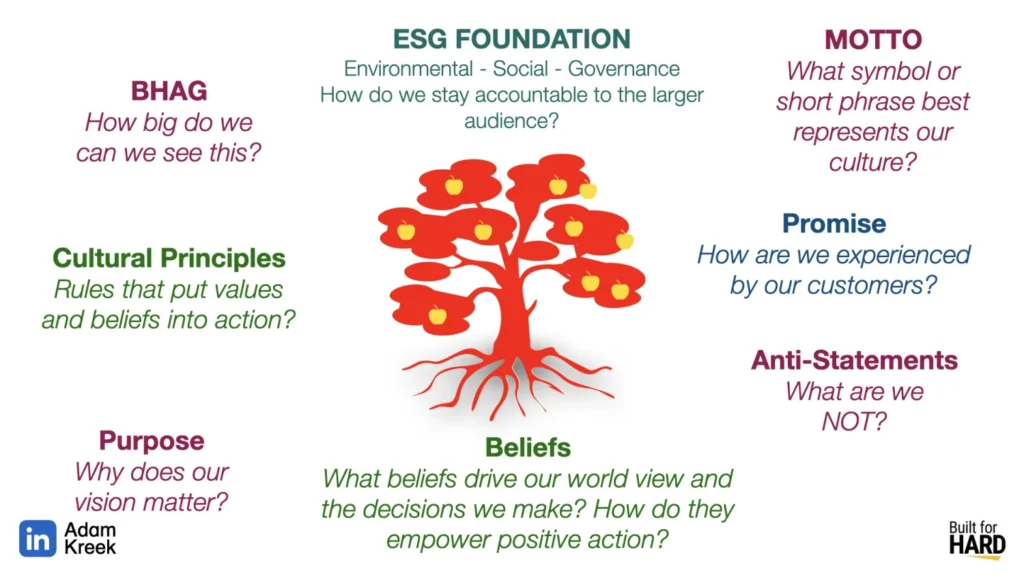
You want cohesion?
When done right, your shared team philosophy becomes a living framework that drives decisions, powers execution, and builds trust. This is not fluffy stuff. It’s business-critical.
Here’s the process I use to guide teams during Built for Hard™ strategy sprints. This isn’t about wordsmithing pretty statements. It’s about gutting out effective statments that align your behaviour with your beliefs—together.
Start with shared clarity.
When done right, your philosphy becomes a living framework that drives decisions, powers execution, and builds trust. This is not fluffy stuff. It’s business-critical.
Here’s the process I guide teams through during Built for Hard™ strategy sprints. This isn’t about wordsmithing pretty statements. It’s about aligning your behaviour with your beliefs—together.
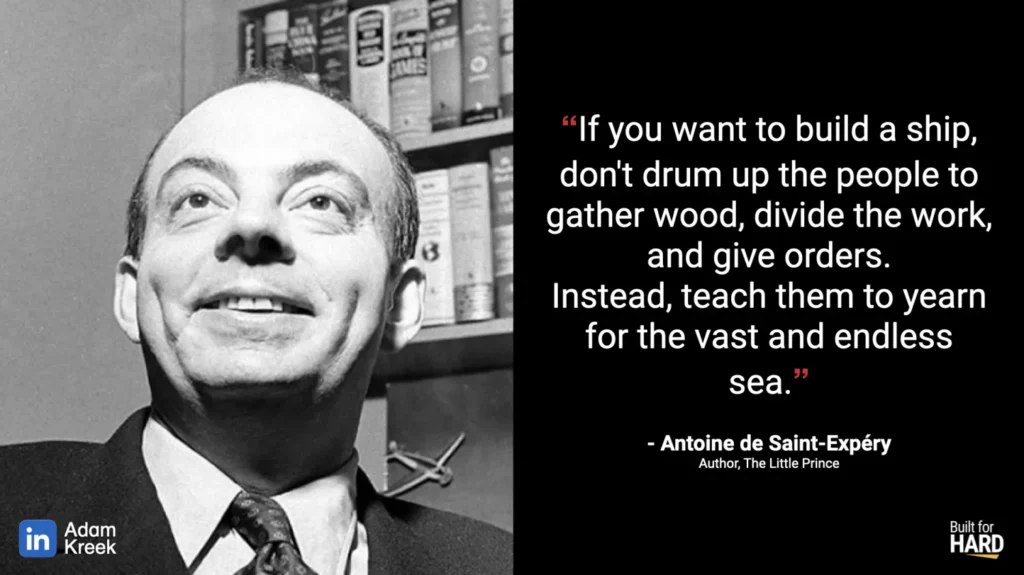
PREPARATION: Crafting Your Shared Philosophy
Crafting a shared philosophy is more of an art than a science. The words you choose are rooted in meaning, and how your team articulates this meaning can vary widely. I’ve guided dozens of teams through this process, and I’ve found that the most powerful philosophies are memorable, repeatable, and used daily.
There’s no single formula. Some teams lean into mission, vision, and values. Others add principles, promises, or mottos. The key is to choose the tools that resonate most with your people—not to tick boxes or copy another company’s playbook.
Here are the most common tools, and how to uncover them:
- Mission → What we do every day.
Your mission is the engine of your team. It defines the consistent action you deliver, again and again. Ask: What’s the thing we do that is never done doing? Keep it short and energizing. Your mission statement is not your values. - Vision → Where we are going.
Your vision is the horizon line. It paints a vivid picture of the future you’re building. Ask: If we did our mission flawlessly, how would the world be different? A great vision is ambitious, inspiring, and clear enough to rally around. - Values → How we show up.
Values are your emotional drivers—the character traits and subconscious judgement calls you expect your teammates to make. They act as decision fuel, guiding choices in moments of uncertainty. Ask: What behaviours make us proud to work here? and What behaviours get punished, even quietly? then What subconscious value judgements underpin each of these positive and negative actions? - Purpose → Why it matters.
Purpose is the anchor. It answers the deep question: Why does our vision matter? It rarely changes and speaks to the higher impact of your work. Teams often discover purpose by asking: Who would miss us if we disappeared tomorrow? - Principles → Rules that put values into action.
Principles translate abstract values into practical behaviours. For example, if you value “connection,” a principle might be: “We pick up the phone before sending a third email.” Principles make your philosophy actionable. They guide you behaviours in your organization. Organizations often define their culture with a document that overviews the cultural principles driving their interactions and decisions. - Beliefs → Truths we hold to be true
Beliefs are the deeply held convictions that shape how we see the world and guide our actions. They sit beneath the surface—often unspoken—and form the foundation of our values. For teams, shared beliefs shape identity and cohesion. They help individuals align, create consistency in decision-making, and fuel action that matches conviction. - BHAG (Big Hairy Audacious Goal) → What stretches us.
Popularized by Jim Collins, the BHAG is the bold, 15–25 year challenge that galvanizes your people. It should feel almost impossible—and worth chasing anyway. Ask: How big can we see this? - Promise → How we’re experienced by others.
A promise is outward-facing. It defines the consistent experience your customers, clients, or partners can expect from you. - Motto → What captures culture in shorthand.
A motto can be a rallying cry, a shorthand to give more excitement to your team. A pithy statement like this can be easy to remember, and will sharpen your identity and help your team members make faster decisions. - Anti-Statements → What your team is definately not.
Sometimes its easier to define yourself by what you are not. These are optional, but they have been very effective with some teams looking for more differentiation between what they do and the common confusions that customers have with their delivery.
Not every team will need all of these. The exercise is not about quantity—it’s about resonance. The right mix of tools will leave your team saying: Yes. That’s us. That’s why we’re here.
When that happens, your philosophy stops being words on a slide—and becomes the invisible glue that holds your team together.
What Really Matters
Netflix’s cultural document is a fascinating example of corporate philosophy because it doesn’t bother drawing neat lines between vision, purpose, mission, values, or principles. Instead, it blends them together into one long narrative about “how we do things here.” You’ll see principled mantras like “People over process” alongside nuanced value judgements like “Freedom and responsibility,” and aspirations about shaping the future of entertainment. Academically, it’s messy. But in practice, that fuzziness works. When you read it, you can instantly feel whether you’d thrive—or crash and burn—inside Netflix’s world.
That’s the paradox of defining culture: clarity matters, but precision isn’t the goal. What matters is whether the document rings true. Netflix’s culture page does exactly that. It shows you how decisions get made, how people behave, and what kind of ambition fuels the company. That’s what makes it powerful—not its tidy definitions, but its emotional accuracy. Culture is less about semantics and more about whether your beliefs, behaviours, and aspirations show up honestly on the page.
And if you’re still arguing over whether your mission is really a vision, or your values are actually principles—don’t worry. Your people are less concerned about the label and more concerned about whether they’ll get fired for sharing their password to salesforce.
STEP 1: Pick Your Philosophical Tools
I like values. You’ve probably figured that out if you’ve been reading this blog. Values are powerful—they guide behaviour, set expectations, and shape culture. Yet, they are often conflated with other concepts, confusing, or just way too obvious.
But after facilitating dozens of philosophical definition sessions, I’ve realized not every team connects with values in the same way. Some don’t fully understand them, others don’t see their immediate utility. And that’s okay.
For this blog, I want to zero in on the three tools that almost every team finds useful: Mission, Vision, and Purpose. These are the biggest levers that can unify your people, create cohesion, and spark motivation.
If you’re facilitating this conversation on your own, you might discover other constructs that resonate more deeply with your team—like principles, beliefs, or even mottos. If so, go with them. The point isn’t to force-fit someone else’s model. It’s to uncover the words that feel true and motivating for your team.
Here’s where to start:
- Mission → Focus for the work at hand. It defines the daily activity your team commits to again and again. A clear mission avoids “mission creep” where the company or team focuses on too many things.
- Vision → A picture of the future. It describes the change you are enacting, the impact you are creating. You are changing the world with your mission. Be clear on what that new world looks like.
- Purpose → The deeper why. It’s the motivation that inspires your team to go the extra mile and stay committed when the work gets hard. Your team is making an impact on individuals, industries and organizations. Be clear on the difference you are making.
These three tools give your team both roots and wings: grounded in clarity, yet lifted by a bigger future.
Discovering your team's values is incredibly useful, as well. To see how values interact with beliefs and principles, read this blog with examples and case studies of How to Discover Core Values for your Company, Team, Organization.
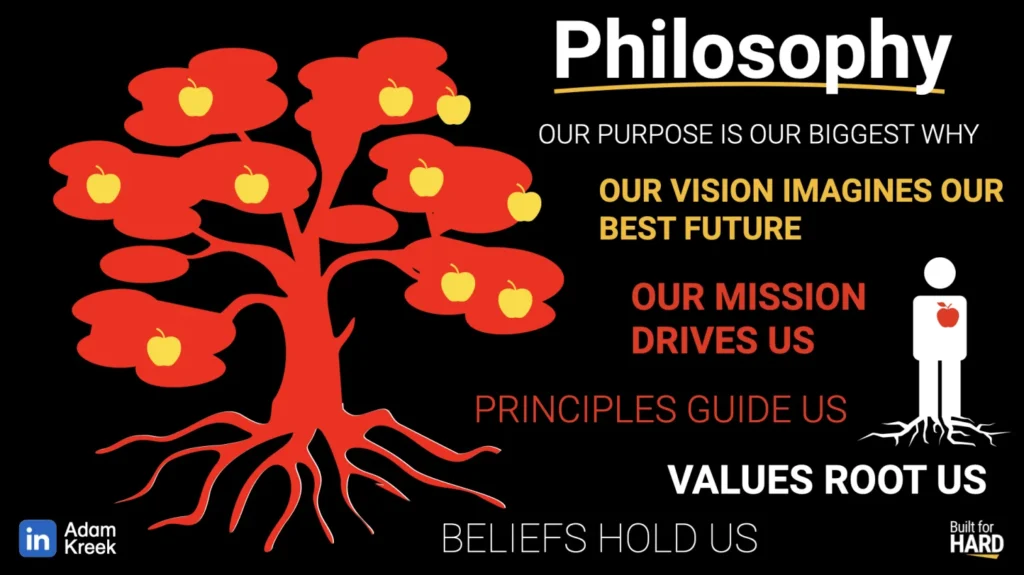
Step 2: Clarify Your Mission
Your mission is your what.
The clear, focused action your team commits to delivering every single day.
It should be short, simple, and energizing.
Ask yourselves:
- What service do we actually provide?
- What’s the consistent through-line across everything we do?
Example Mission:
“We coach, consult, and lead cultural growth for values-driven organizations.”
Forget buzzwords. You’re not trying to win a branding award—you’re trying to give your team a compass they’ll actually use.
With a strong mission, you can drive a mission-focused leadership culture.
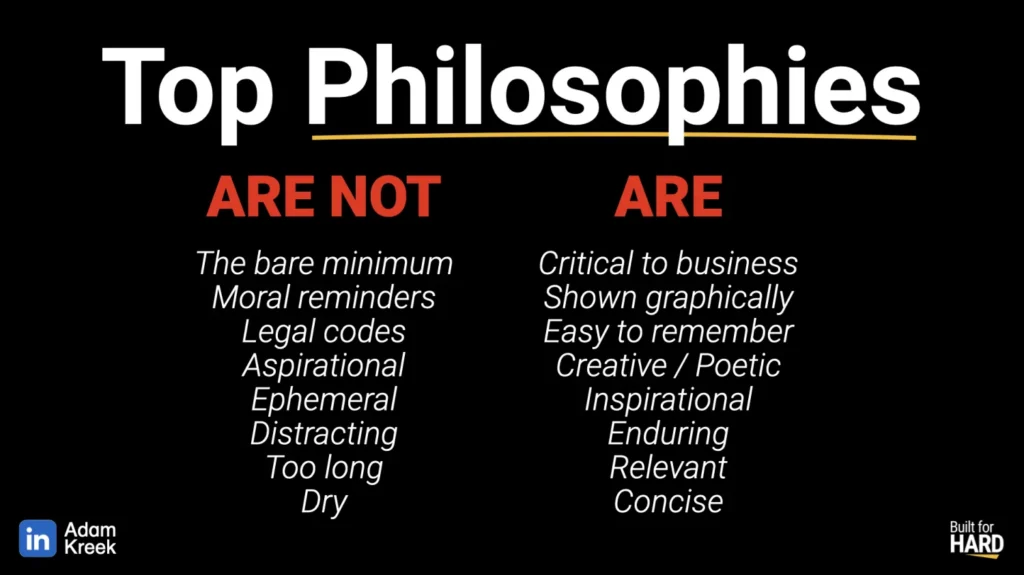
Step 3: Define Your Vision
Your vision is your where.
It’s the meaningful future you’re all rowing toward—whether you’re in a storm or dead calm.
I've written about finding your personal vision and purpose, and this could help you as you help guide your team to finding a shared vision.
The best visions are audacious, but believable.
They stretch your capacity without snapping it.
Ask:
- What would the world look like if we delivered our mission flawlessly?
- Who would we become if we fully lived our values? What would our industry look like? How is the world changed for the better?
Example Vision:
“Be the go-to thought leader in organizational health and high performance.”
This is the big horizon that keeps your crew aligned—even when the waves hit hard.

Step 4: Anchor to Purpose
Purpose is your why.
It’s the deeper motivation behind your work.
And unlike your mission or vision—it rarely changes.
Purpose goes beyond product.
It transcends KPIs.
It speaks to the reason your team chooses this hard thing, together.
Ask:
- Why does this work matter to us?
- If this company disappeared tomorrow, who would miss us—and why?
- What human transformations do we make easier with our products, services and partnerships?
Example Purpose:
“To develop leaders and organizations to achieve real results through meaningful support.”
You’ll know you’ve hit your purpose when it resonates like a bell—deep, personal, undeniable.
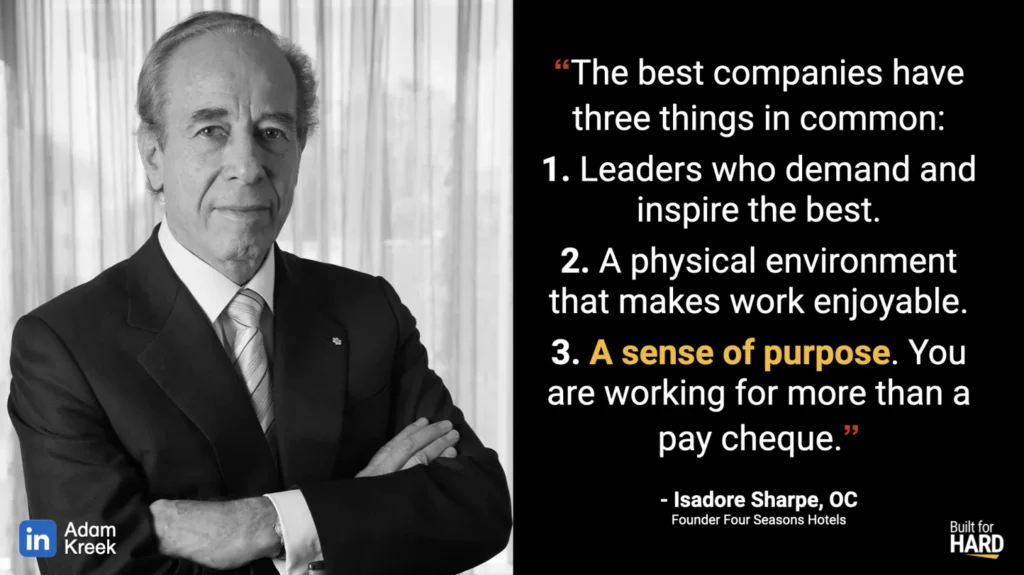
Final Step: Make it Useful
Inculcation : Training Your Team Into Culture
If your team philosophy lives in a Google Doc, you’ve wasted your time. If it’s a weekend exercise that ends up laminated on the wall but never talked about, don’t even bother.
Culture only works when it’s inculcated—a fancy word that means teaching and instilling an idea through repetition and lived practice. In plain terms: you set the tone, you model the behaviour, and you keep reinforcing it until it sticks.
One of the most common frustrations I hear from leaders is that they feel like parents, constantly retraining people who just aren’t “getting it.” That’s not a failure of the team—it’s part of the job. Leadership is about drawing the line between what you tolerate and what you will not tolerate in the culture you’re building.
When I was training Olympic athletes, I knew that a new behaviour or technique needed to be repeated at least thirteen times before it became integrated. That’s with the best in the world—the people who are already wired for discipline and excellence. If Olympians need that much reinforcement, think about how much more repetition is required inside your organization.
This is the hard truth: inculcation isn’t a one-and-done exercise. It’s a daily practice of reminding, retraining, and re-anchoring your people into the philosophy of the business. If you want a culture that’s sustainable, productive, and powerful, you need to live it out loud—again and again—until it becomes second nature for everyone in the room.
Ways to Inculcate Your Philosophy
Once you’ve aligned on MVP (Mission, Vision, Purpose):
- Start meetings by referencing your vision, mission, purpose.
- Use the mission to focus quarterly goals.
- Point back to the vision during tough decisions.
- Celebrate wins that reflect your shared purpose.
- Build an AI SOP GPT that is trained in your corporate philosophy and uses the language of your culture
- Pick more ideas from this blog and put your philosophy to work for your business
This is cultural design. And it’s how we build teams that last.
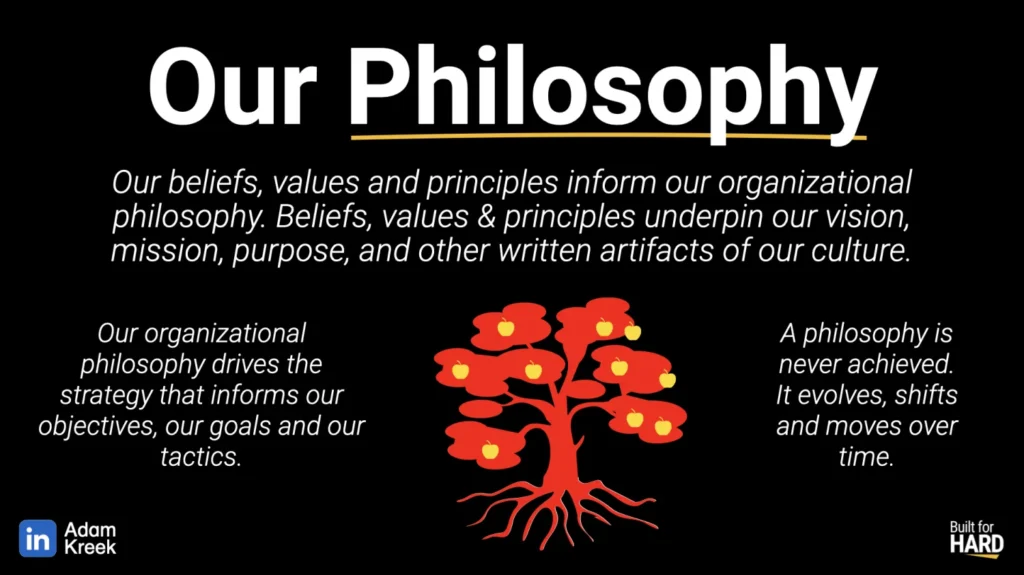
Examples of Corporate philosophies
Below, you sill see examples of corporate philosophies, used to unite and align their people and culture. A clear philosophy feels good and is resonant with the best people in your team or organization.
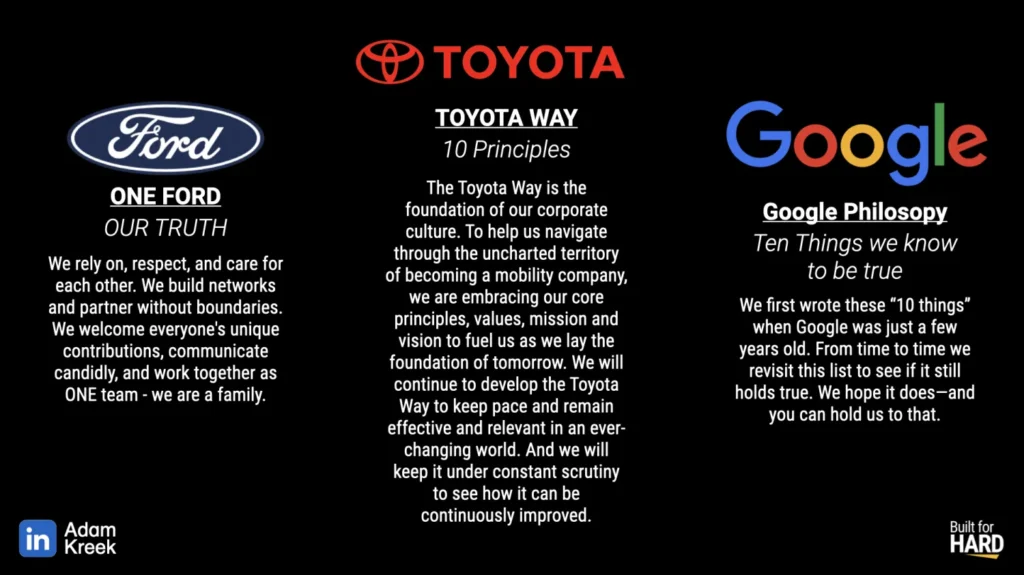
BONUS: The Yin-Yang of Team Alignment
Most teams I work with either have goals with no grounding, or grounding with no goals. Both approaches fall flat.
That’s why I like to use a Yin-Yang model of team alignment. On one side, you need philosophy—your mission, values, and purpose. This is the Yin. It’s reflective, steady, and grounding. It defines how you behave every day and why you choose to show up. It’s the root system that keeps the tree standing tall when the storms come.
On the other side, you need big goals—your vision and BHAG (Big Hairy Audacious Goal). This is the Yang. It’s bold, motivating, and directional. It pulls the team forward into a bigger future, creating a sense of energy and urgency. Without it, you can end up with endless reflection and very little momentum.
Your BHAG, when defined, will influence real and achievable goals in your 4HAG, 1HAG and 90-Day sprints, then informs the meeting and execution cadence of your organization.
The power comes from holding both together. Yin without Yang turns into navel-gazing—lots of talk about values, but no action. Yang without Yin turns into chaos—big goals that burn people out because there’s no grounding in purpose. Jim Collins wrote about this in Harvard Business Review years ago: enduring organizations marry a deeply rooted philosophy with ambitious goals that stretch decades into the future.
Or, in my words: get clear on who you are, then row hard toward where you’re going. That balance is what creates cohesion, alignment, and performance that lasts.
- Yin: Shared Philosophy (the grounding energy)
This is your mission, values, and purpose. It’s what roots you. It’s the character of your team—the principles and behaviours that define how you operate every day.
Yin energy is reflective, grounding, and stabilizing. It’s the “why” and the “how” that keeps you steady when the storms come. - Yang: Big Goals (the driving energy)
This is your vision and BHAG (Big Hairy Audacious Goal). It’s what pulls you forward into the future. It’s bold, aspirational, and motivating.
Yang energy is expansive, directional, and energizing. It’s the “what” and the “where” that rallies your team to chase something bigger than themselves.
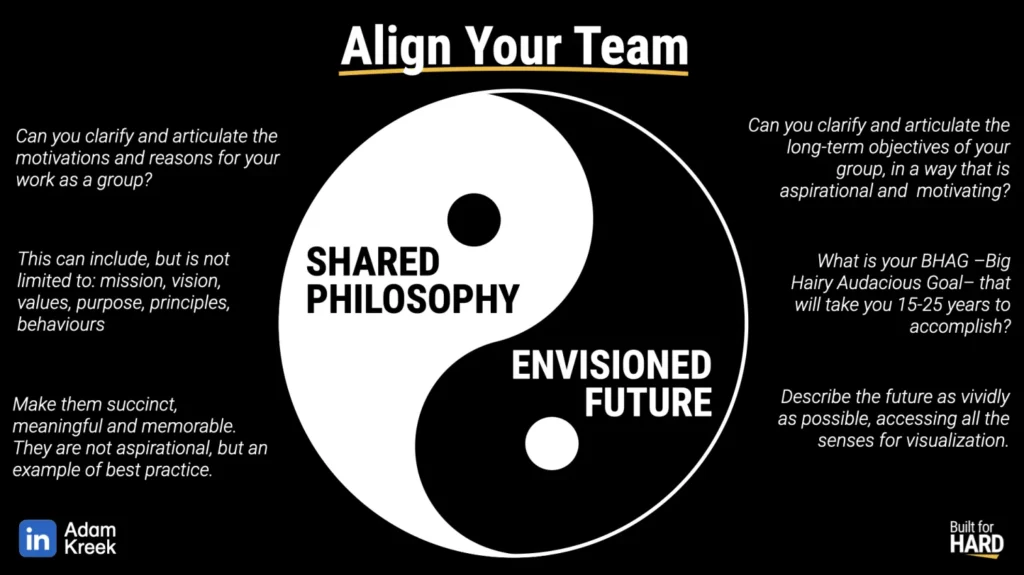
The Point:
Great teams need both.
- Too much Yang (goals without grounding) → burnout, chaos, ego-driven decisions.
- Too much Yin (philosophy without goals) → navel-gazing, stagnation, “all talk, no action.”
As Jim Collins put it in HBR years ago: enduring organizations marry a deeply rooted philosophy with ambitious goals that stretch decades into the future.
A philosophy is useless if you do nothing with it.
Final Thought:
A team aligned on mission, vision, values, and purpose doesn’t just work better.
They win better—together.
And if you got this far in reading this post? I know you’re a winner. Reach out. I’d love to explore how we can work together to achieve bigger, more meaningful outcomes.
–––––
Adam Kreek and his team are on a mission to positively impact organizational cultures and leaders who make things happen.
He authored the bestselling business book, The Responsibility Ethic: 12 Strategies Exceptional People Use to Do the Work and Make Success Happen.
Discover our thoughts on Values here.
Want to increase your leadership achievement? Learn more about Kreek’s coaching here.
Want to book a keynote that leaves a lasting impact? Learn more about Kreek’s live event service here.